Page 204 of 437
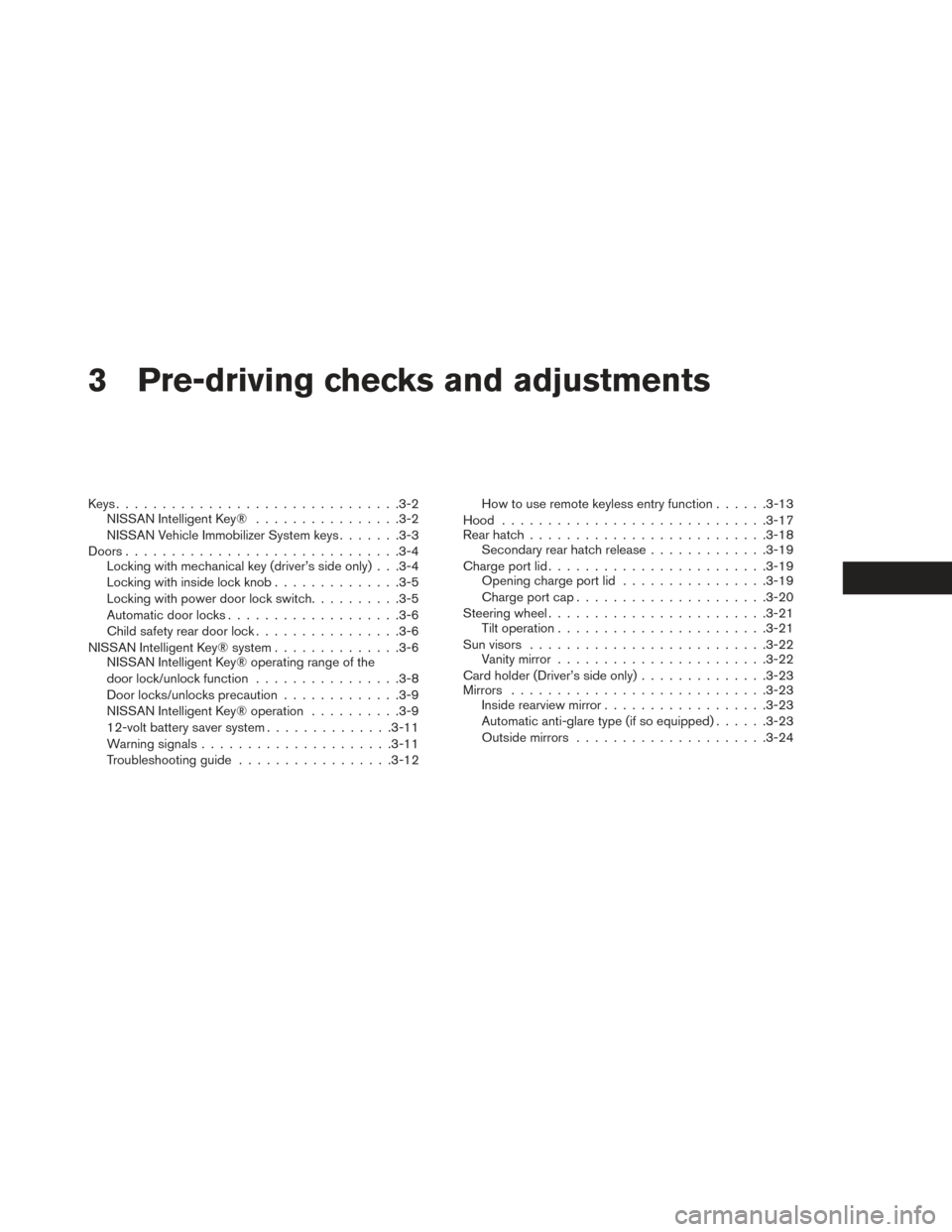
3 Pre-driving checks and adjustments
Keys...............................3-2
NISSAN Intelligent Key® ................3-2
NISSAN Vehicle Immobilizer System keys .......3-3
Doors ............................. .3-4
Locking with mechanical key (driver’s side only) . . .3-4
Locking with inside lock knob ..............3-5
Locking with power door lock switch ..........3-5
Automatic door locks .................. .3-6
Child safety rear door lock ................3-6
NISSAN Intelligent Key® system ..............3-6
NISSAN Intelligent Key® operating range of the
door lock/unlock function ................3-8
Door locks/unlocks precaution .............3-9
NISSAN Intelligent Key® operation ..........3-9
12-volt battery saver system ..............3-11
Warning signals .................... .3-11
Troubleshooting guide ................ .3-12How to use remote keyless entry function
......3-13
Hood ............................ .3-17
Rear hatch ......................... .3-18
Secondary rear hatch release .............3-19
Charge port lid ....................... .3-19
Opening charge port lid ................3-19
Charge port cap .................... .3-20
Steering wheel ....................... .3-21
Tilt operation ...................... .3-21
Sun visors ......................... .3-22
Vanity mirror ...................... .3-22
Card holder (Driver’s side only) ..............3-23
Mirrors ........................... .3-23
Inside rearview mirror ................. .3-23
Automatic anti-glare type (if so equipped) ......3-23
Outside mirrors .................... .3-24
Page 224 of 437
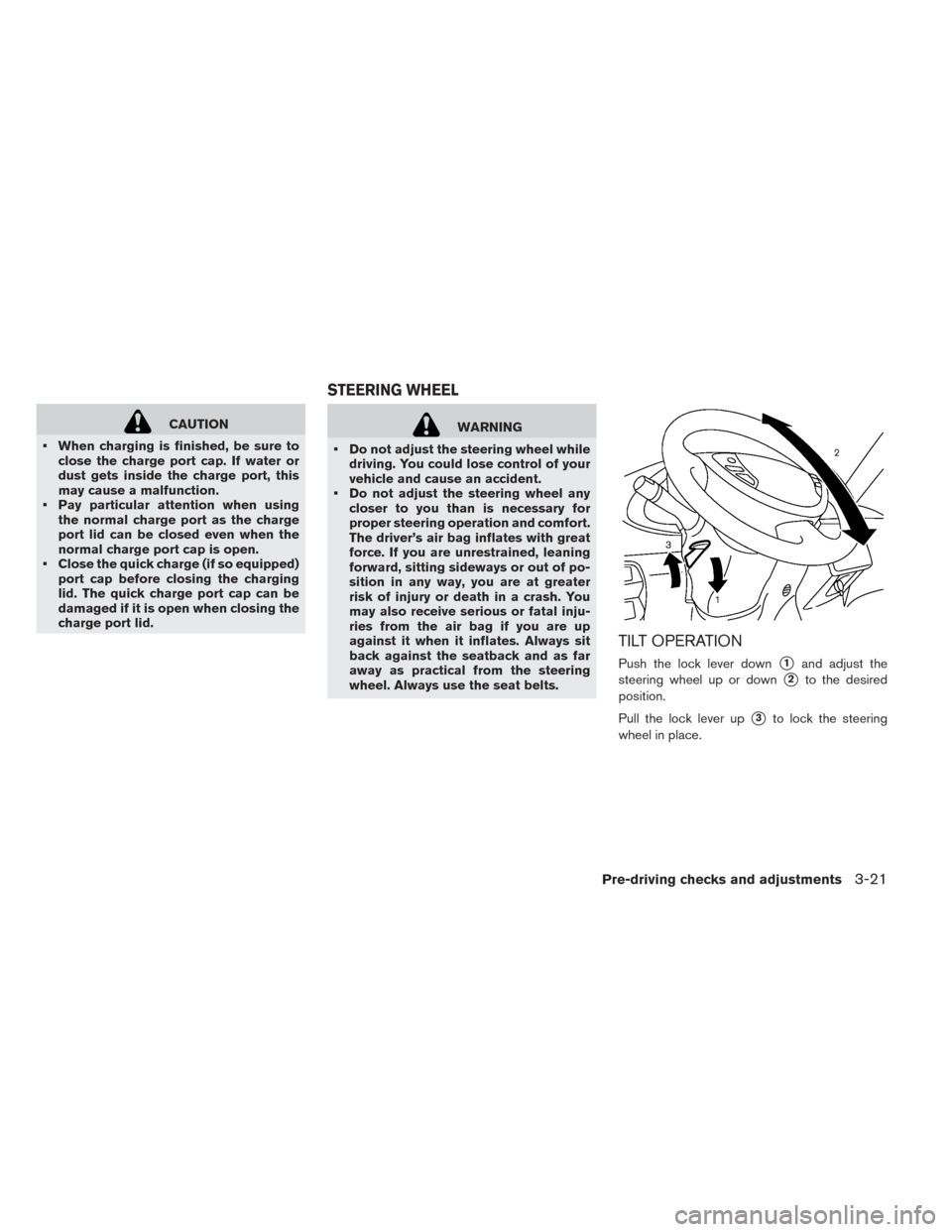
CAUTION
• When charging is finished, be sure to close the charge port cap. If water or
dust gets inside the charge port, this
may cause a malfunction.
• Pay particular attention when using the normal charge port as the charge
port lid can be closed even when the
normal charge port cap is open.
• Close the quick charge (if so equipped) port cap before closing the charging
lid. The quick charge port cap can be
damaged if it is open when closing the
charge port lid.WARNING
• Do not adjust the steering wheel while driving. You could lose control of your
vehicle and cause an accident.
• Do not adjust the steering wheel any closer to you than is necessary for
proper steering operation and comfort.
The driver’s air bag inflates with great
force. If you are unrestrained, leaning
forward, sitting sideways or out of po-
sition in any way, you are at greater
risk of injury or death in a crash. You
may also receive serious or fatal inju-
ries from the air bag if you are up
against it when it inflates. Always sit
back against the seatback and as far
away as practical from the steering
wheel. Always use the seat belts.
TILT OPERATION
Push the lock lever down�1and adjust the
steering wheel up or down
�2to the desired
position.
Pull the lock lever up
�3to lock the steering
wheel in place.
STEERING WHEEL
Pre-driving checks and adjustments3-21
Page 231 of 437
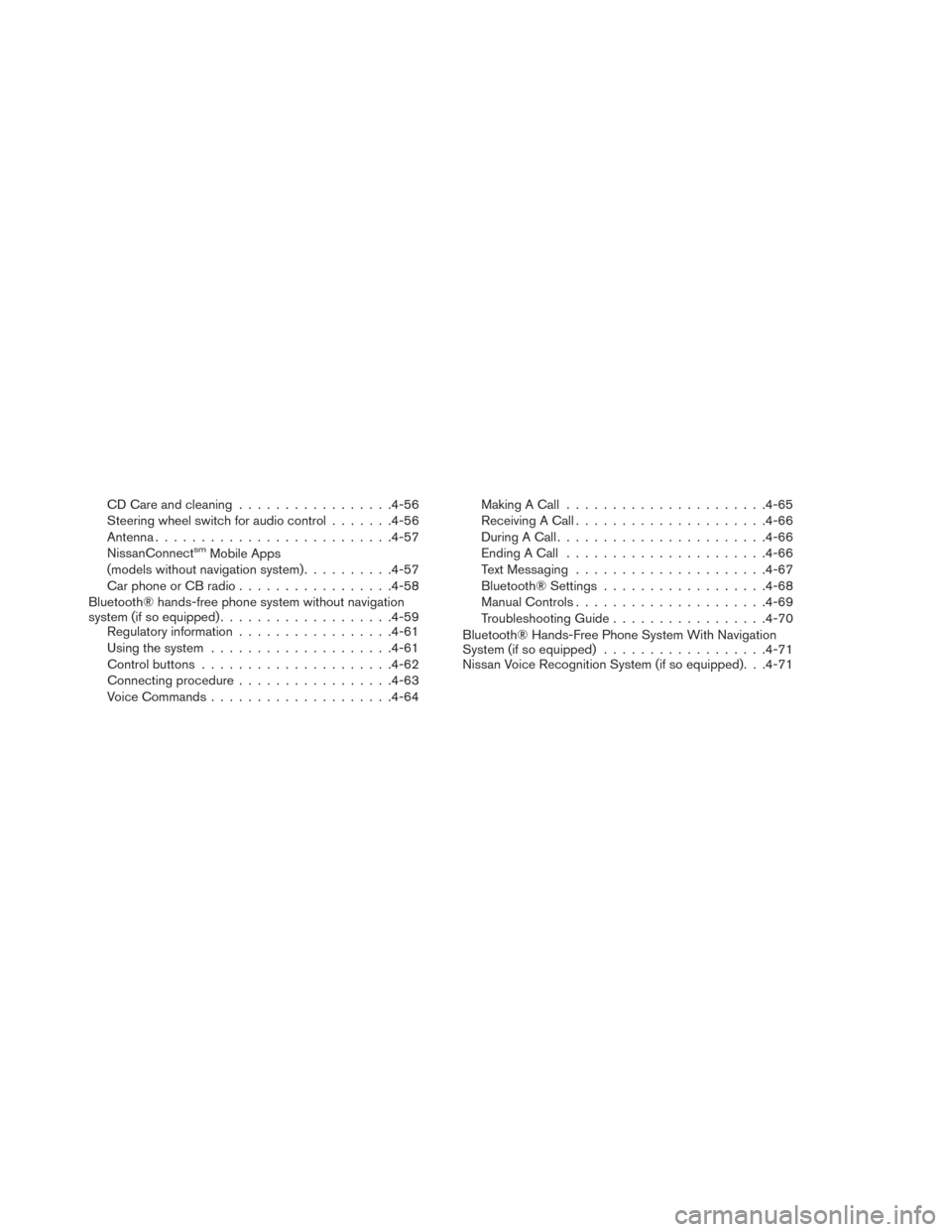
CD Care and cleaning................ .4-56
Steering wheel switch for audio control .......4-56
Antenna ......................... .4-57
NissanConnect
smMobile Apps
(models without navigation system) ..........4-57
Car phone or CB radio ................ .4-58
Bluetooth® hands-free phone system without navigation
system (if so equipped) .................. .4-59
Regulatory information ................ .4-61
Using the system ................... .4-61
Control buttons .................... .4-62
Connecting procedure ................ .4-63
Voice Commands ................... .4-64Making A Call
..................... .4-65
Receiving A Call .................... .4-66
During A Call ...................... .4-66
Ending A Call ..................... .4-66
Text Messaging .................... .4-67
Bluetooth® Settings ................. .4-68
Manual Controls .................... .4-69
Troubleshooting Guide ................ .4-70
Bluetooth® Hands-Free Phone System With Navigation
System (if so equipped) ................. .4-71
Nissan Voice Recognition System (if so equipped). . .4-71
Page 234 of 437
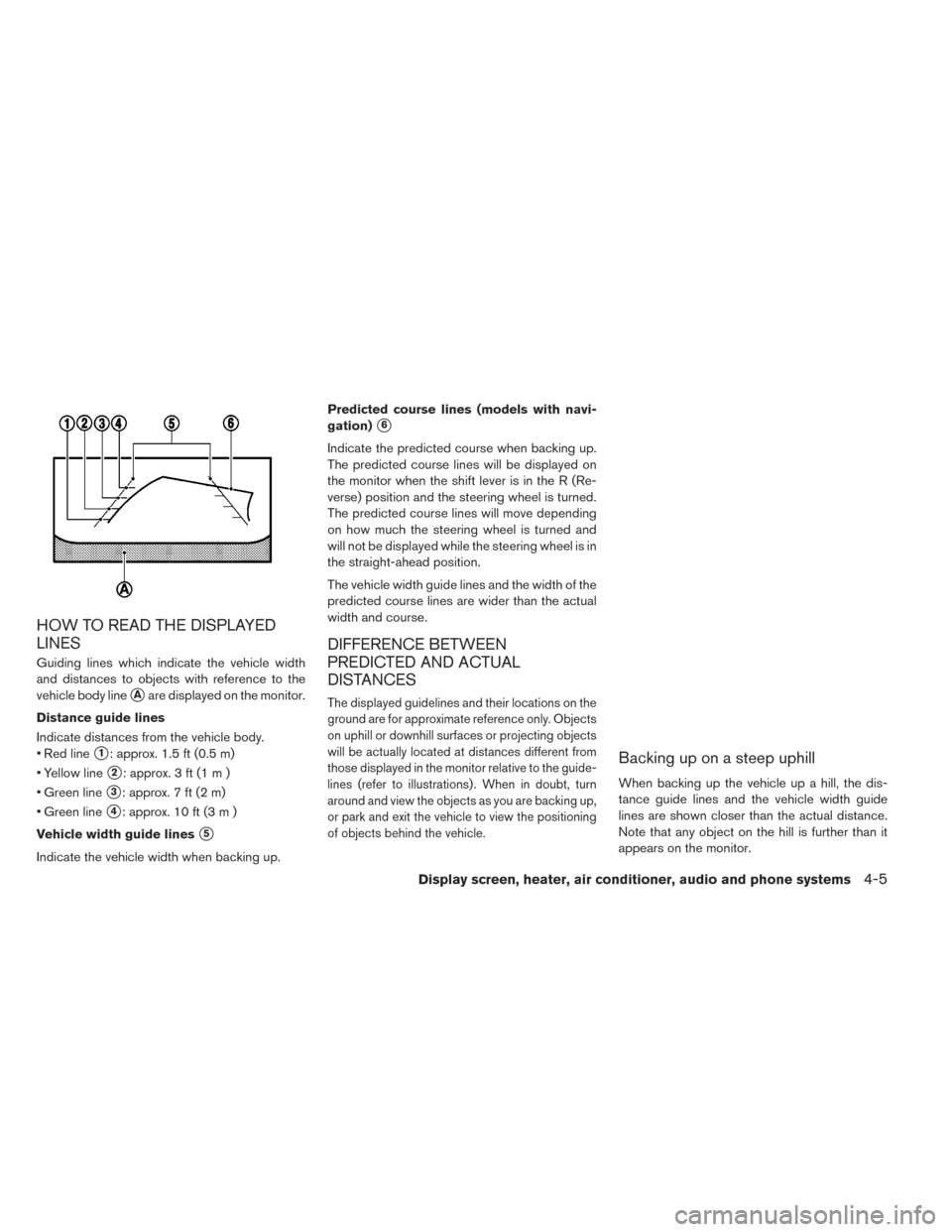
HOW TO READ THE DISPLAYED
LINES
Guiding lines which indicate the vehicle width
and distances to objects with reference to the
vehicle body line
�Aare displayed on the monitor.
Distance guide lines
Indicate distances from the vehicle body.
• Red line
�1: approx. 1.5 ft (0.5 m)
• Yellow line
�2: approx. 3 ft (1 m )
• Green line
�3: approx. 7 ft (2 m)
• Green line
�4: approx. 10 ft (3 m )
Vehicle width guide lines
�5
Indicate the vehicle width when backing up. Predicted course lines (models with navi-
gation)
�6
Indicate the predicted course when backing up.
The predicted course lines will be displayed on
the monitor when the shift lever is in the R (Re-
verse) position and the steering wheel is turned.
The predicted course lines will move depending
on how much the steering wheel is turned and
will not be displayed while the steering wheel is in
the straight-ahead position.
The vehicle width guide lines and the width of the
predicted course lines are wider than the actual
width and course.
DIFFERENCE BETWEEN
PREDICTED AND ACTUAL
DISTANCES
The displayed guidelines and their locations on the
ground are for approximate reference only. Objects
on uphill or downhill surfaces or projecting objects
will be actually located at distances different from
those displayed in the monitor relative to the guide-
lines (refer to illustrations) . When in doubt, turn
around and view the objects as you are backing up,
or park and exit the vehicle to view the positioning
of objects behind the vehicle.
Backing up on a steep uphill
When backing up the vehicle up a hill, the dis-
tance guide lines and the vehicle width guide
lines are shown closer than the actual distance.
Note that any object on the hill is further than it
appears on the monitor.
Display screen, heater, air conditioner, audio and phone systems4-5
Page 236 of 437
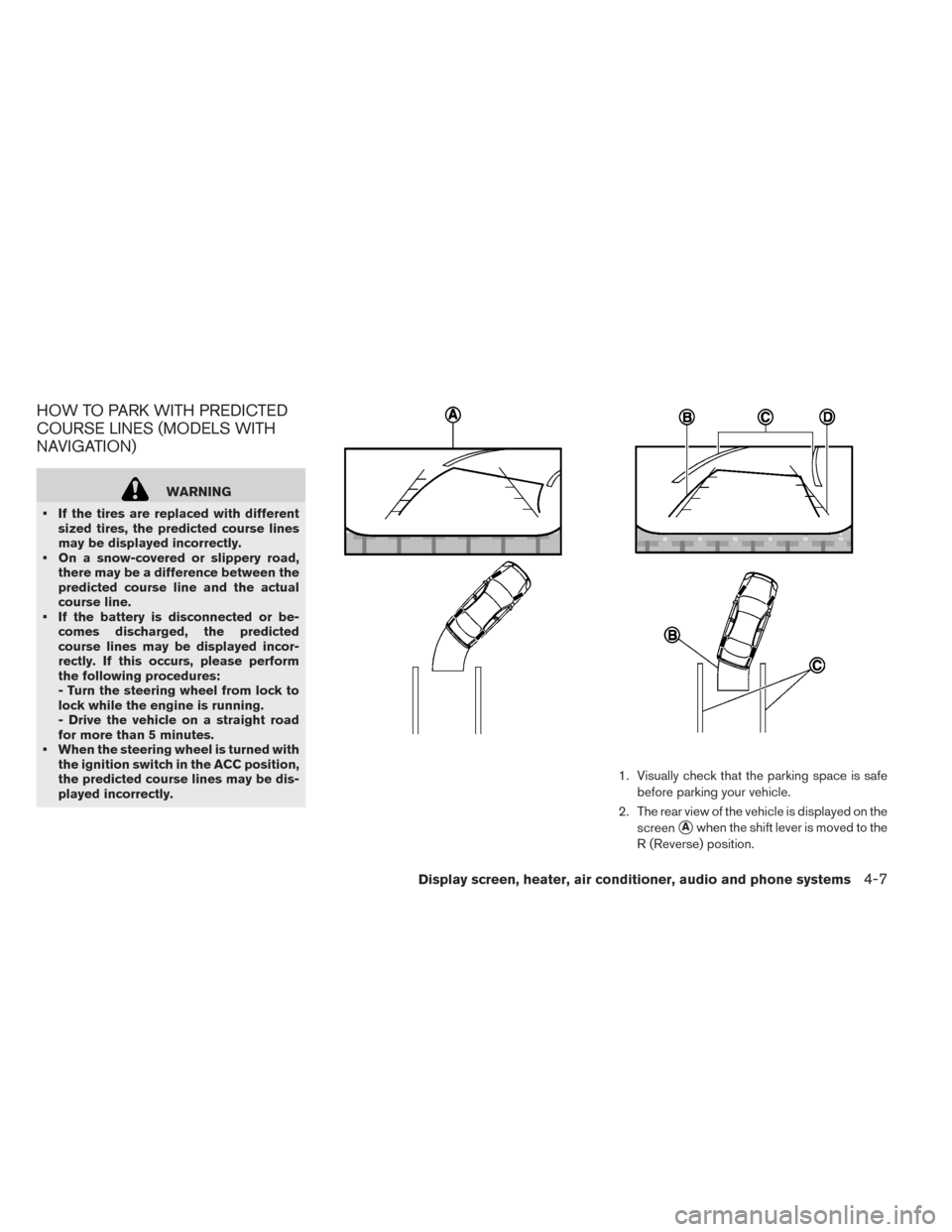
HOW TO PARK WITH PREDICTED
COURSE LINES (MODELS WITH
NAVIGATION)
WARNING
• If the tires are replaced with different sized tires, the predicted course lines
may be displayed incorrectly.
• On a snow-covered or slippery road, there may be a difference between the
predicted course line and the actual
course line.
• If the battery is disconnected or be- comes discharged, the predicted
course lines may be displayed incor-
rectly. If this occurs, please perform
the following procedures:
- Turn the steering wheel from lock to
lock while the engine is running.
- Drive the vehicle on a straight road
for more than 5 minutes.
• When the steering wheel is turned with the ignition switch in the ACC position,
the predicted course lines may be dis-
played incorrectly. 1. Visually check that the parking space is safe
before parking your vehicle.
2. The rear view of the vehicle is displayed on the screen
�Awhen the shift lever is moved to the
R (Reverse) position.
Display screen, heater, air conditioner, audio and phone systems4-7
Page 237 of 437
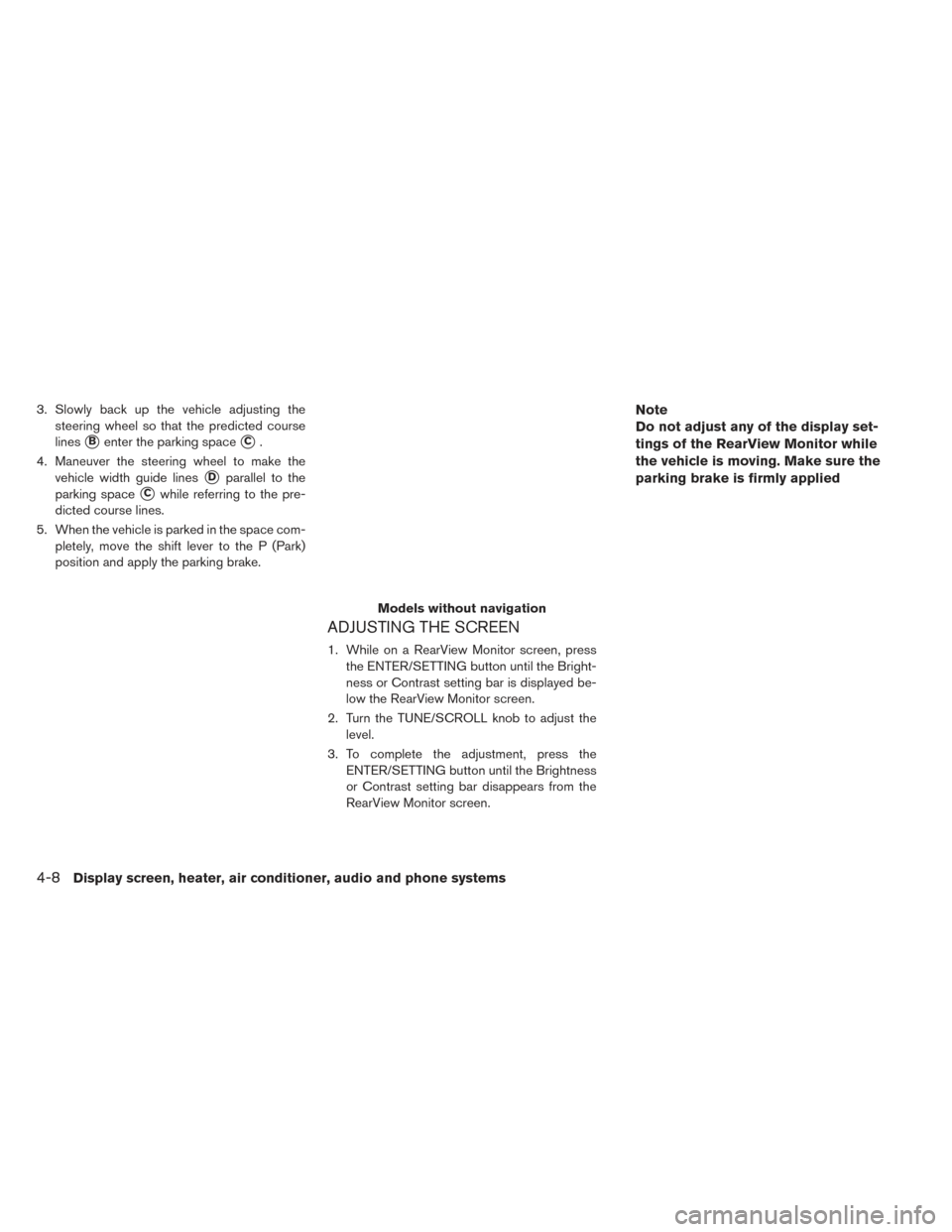
3. Slowly back up the vehicle adjusting thesteering wheel so that the predicted course
lines
�Benter the parking space�C.
4. Maneuver the steering wheel to make the vehicle width guide lines
�Dparallel to the
parking space
�Cwhile referring to the pre-
dicted course lines.
5. When the vehicle is parked in the space com- pletely, move the shift lever to the P (Park)
position and apply the parking brake.
ADJUSTING THE SCREEN
1. While on a RearView Monitor screen, pressthe ENTER/SETTING button until the Bright-
ness or Contrast setting bar is displayed be-
low the RearView Monitor screen.
2. Turn the TUNE/SCROLL knob to adjust the level.
3. To complete the adjustment, press the ENTER/SETTING button until the Brightness
or Contrast setting bar disappears from the
RearView Monitor screen.
Note
Do not adjust any of the display set-
tings of the RearView Monitor while
the vehicle is moving. Make sure the
parking brake is firmly applied
Models without navigation
4-8Display screen, heater, air conditioner, audio and phone systems
Page 243 of 437
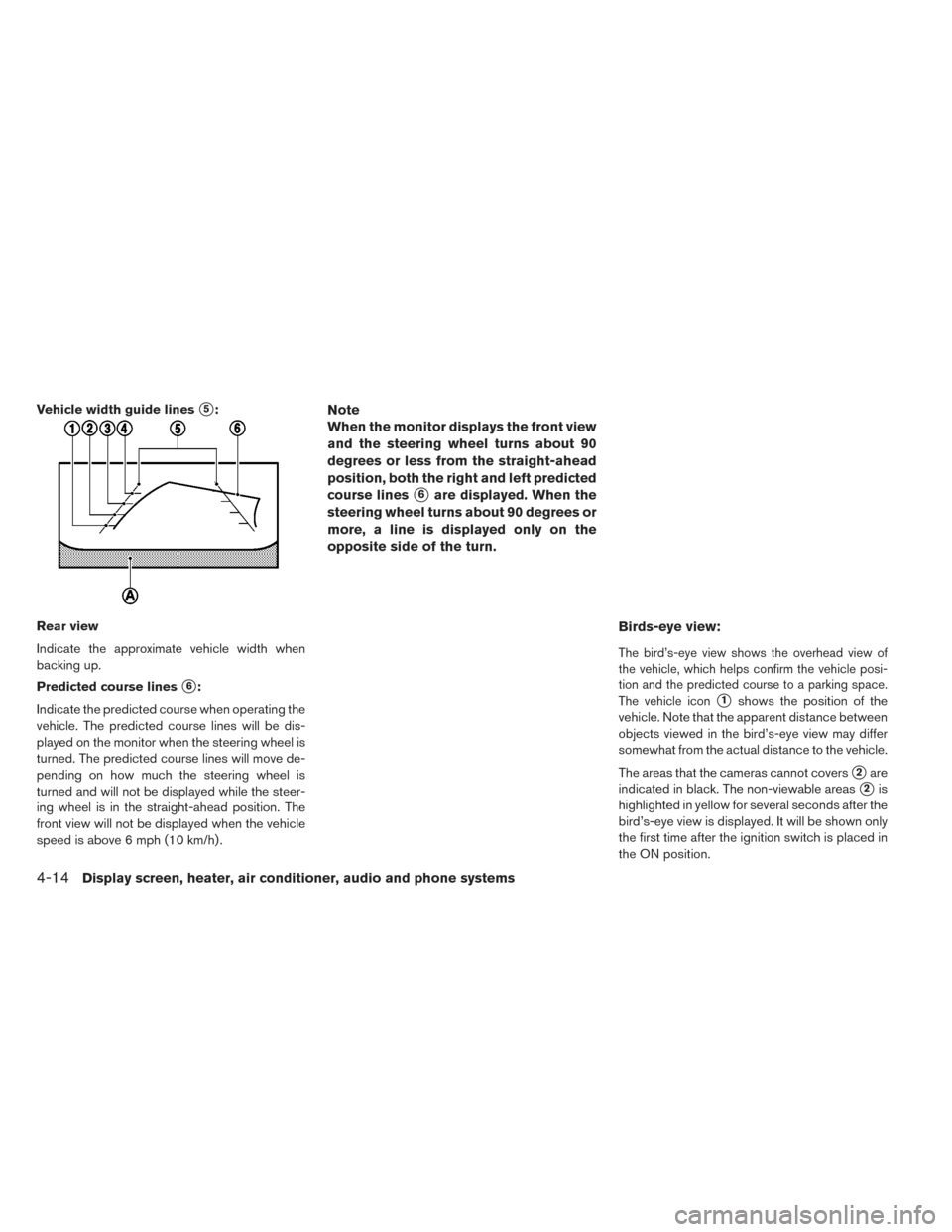
Vehicle width guide lines�5:
Rear view
Indicate the approximate vehicle width when
backing up.
Predicted course lines
�6:
Indicate the predicted course when operating the
vehicle. The predicted course lines will be dis-
played on the monitor when the steering wheel is
turned. The predicted course lines will move de-
pending on how much the steering wheel is
turned and will not be displayed while the steer-
ing wheel is in the straight-ahead position. The
front view will not be displayed when the vehicle
speed is above 6 mph (10 km/h) .
Note
When the monitor displays the front view
and the steering wheel turns about 90
degrees or less from the straight-ahead
position, both the right and left predicted
course lines
�6are displayed. When the
steering wheel turns about 90 degrees or
more, a line is displayed only on the
opposite side of the turn.
Birds-eye view:
The bird’s-eye view shows the overhead view of
the vehicle, which helps confirm the vehicle posi-
tion and the predicted course to a parking space.
The vehicle icon
�1shows the position of the
vehicle. Note that the apparent distance between
objects viewed in the bird’s-eye view may differ
somewhat from the actual distance to the vehicle.
The areas that the cameras cannot covers
�2are
indicated in black. The non-viewable areas
�2is
highlighted in yellow for several seconds after the
bird’s-eye view is displayed. It will be shown only
the first time after the ignition switch is placed in
the ON position.
4-14Display screen, heater, air conditioner, audio and phone systems
Page 246 of 437
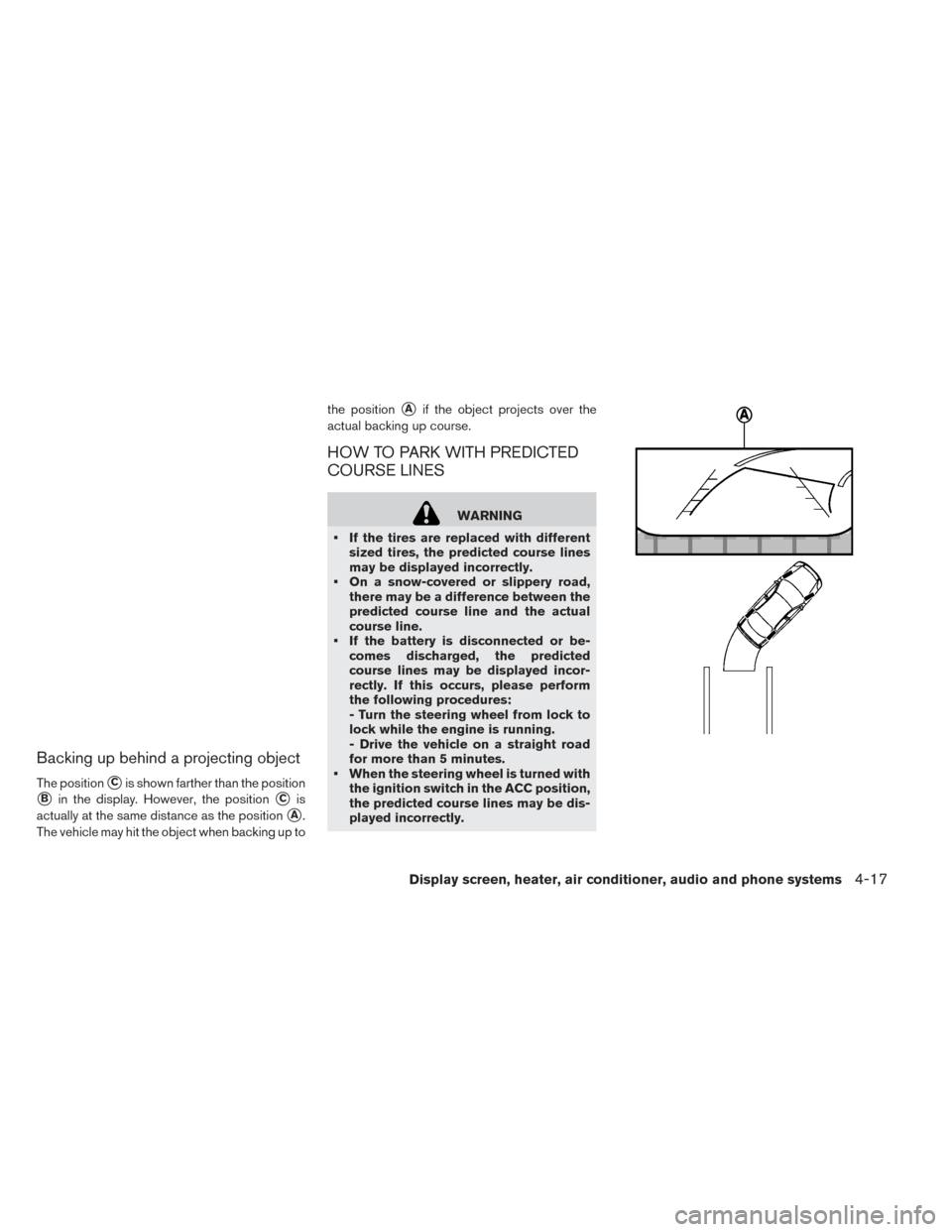
Backing up behind a projecting object
The position�Cis shown farther than the position
�Bin the display. However, the position�Cis
actually at the same distance as the position
�A.
The vehicle may hit the object when backing up to the position
�Aif the object projects over the
actual backing up course.
HOW TO PARK WITH PREDICTED
COURSE LINES
WARNING
• If the tires are replaced with different sized tires, the predicted course lines
may be displayed incorrectly.
• On a snow-covered or slippery road, there may be a difference between the
predicted course line and the actual
course line.
• If the battery is disconnected or be- comes discharged, the predicted
course lines may be displayed incor-
rectly. If this occurs, please perform
the following procedures:
- Turn the steering wheel from lock to
lock while the engine is running.
- Drive the vehicle on a straight road
for more than 5 minutes.
• When the steering wheel is turned with the ignition switch in the ACC position,
the predicted course lines may be dis-
played incorrectly.
Display screen, heater, air conditioner, audio and phone systems4-17